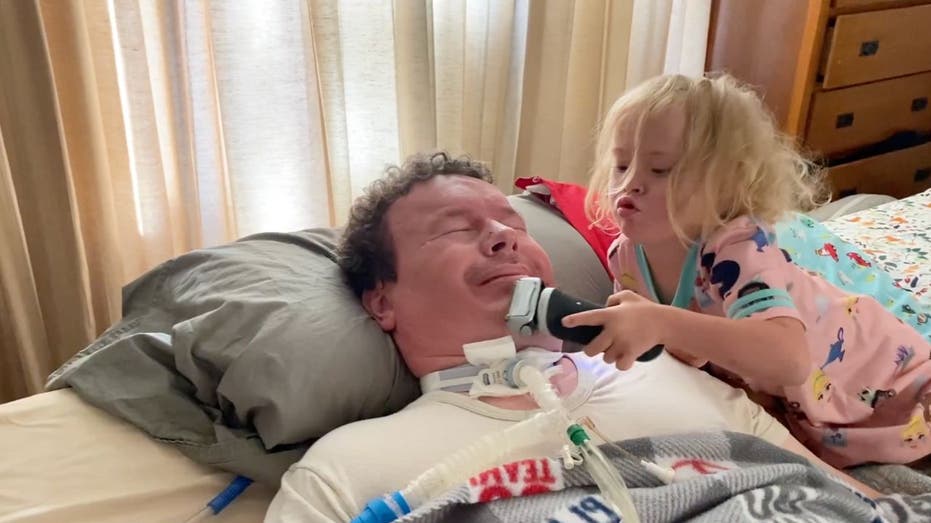Revolutionary Brain Implant Lets ALS Patient Communicate using AI Technology
ALS patient Brad G. Smith regains speech through Neuralink implant, highlighting breakthrough in brain-computer interface technology.

Imagine losing the ability to speak or move, yet still having the desire—and the need—to connect with those around you. For Brad G. Smith, this became his lived experience after being diagnosed with amyotrophic lateral sclerosis (ALS), a progressive and rare neurological disorder that causes degeneration of nerve cells responsible for voluntary muscle movements.
Smith’s journey took a dramatic turn thanks to a groundbreaking Neuralink brain implant. This pioneering device, developed with the promise of bridging the gap between mind and machine, has allowed him to communicate using just his thoughts—a technological leap previously seen only in science fiction. Previously, Smith relied on eye-tracking technology, which, though remarkable, presented frustrating limitations. “It is a miracle of technology, but it is frustrating. It works best in dark rooms, so I was basically Batman. I was stuck in a dark room,” Smith explained. Any change in ambient lighting could disrupt the system, making simple tasks time-consuming or impossible. Now, with the Neuralink device, he enjoys the freedom to communicate in any environment: “Neuralink lets me go outside and ignore lighting changes.”
Notably, Smith became the first non-verbal person—and only the third person worldwide—to receive the Neuralink Brain-Computer Interface (BCI). The device, roughly the thickness of five stacked coins, is nestled within his skull and connected directly to his brain’s motor cortex. Ultra-fine wires, even thinner than a human hair, extend into the region, capturing the electrical impulses fired by neurons. These signals are then transmitted wirelessly to a laptop, where advanced AI decodes them in real time, allowing Smith to move a computer cursor simply by thinking about it.
“The Neuralink implant embedded in my brain contains 1,024 electrodes that capture neuron firings every 15 milliseconds, generating a vast amount of data,” Smith elaborated. “Artificial intelligence processes this data on a connected MacBook Pro to decode my intended movements in real time to move the cursor on my screen. Neuralink does not read my deepest thoughts or words I think about. It just reads how I want to move and moves the cursor where I want.”
Learning to use the system was not without its challenges. Early attempts to map typical hand movement signals to cursor movement were unsuccessful due to Smith's paralysis. Researchers discovered that signals related to tongue movement worked best for moving the cursor, while jaw clenching was the most effective way to ‘click.’ “I am not actively thinking about my tongue, just like you don’t think about your wrist when you move a mouse… My brain has switched over to subconscious control quickly, so I just think about moving the cursor,” Smith shared.
The impact on daily life has been profound. Smith can now play video games, such as Mario Kart, with his children and communicate more fluidly than ever before, thanks to a virtual keyboard and customizable shortcuts for common computing tasks. Together with Neuralink engineers, Smith even helped develop a “parking spot” feature that enables him to park the cursor during passive activities like watching videos.
To further enhance his communication, Smith leverages “Grok,” an artificial intelligence-powered chatbot. Grok listens in on conversations and suggests responses, even replicating Smith's former voice for a personalized touch. "It keeps me in the conversation and it comes up with some great ideas," said Smith. For example, when a friend asked for a birthday gift idea for his horse-loving girlfriend, Grok suggested a humorous yet thoughtful bouquet of carrots.
Behind these breakthroughs stands a network of unwavering support—Smith credits his wife Tiffany and his children for their relentless care and encouragement. He also draws strength from his faith, finding new perspective and resilience through his struggles. “I have not always understood why God afflicted me with ALS but with time I am learning to trust his plan for me. I’m a better man because of ALS. I’m a better disciple of Jesus Christ because of ALS. I’m closer to my amazing wife, literally and figuratively, because of ALS,” Smith reflected.
While Neuralink’s technology remains in its infancy and under close scrutiny from neuro-ethicists concerned about privacy and autonomy, Smith's story represents the dawn of a new era. The company recently earned a breakthrough designation from the FDA for its device, kindling hope for people who suffer from impairments caused by ALS, stroke, spinal cord injuries, and other neurological conditions.
Ultimately, Smith's experience is a testament to human ingenuity and perseverance. Amidst adversity, he has found not only new ways to connect with his loved ones, but also renewed hope and purpose. “Neuralink is giving me freedom, hope, and faster communication. Overall, the whole Neuralink experience has been fantastic. It has improved my life so much. I’m so happy to be involved in something big that will help many people,” Smith said. While the journey with ALS remains difficult, his story illuminates the transformative power of technology—and the indomitable spirit of those it serves.




